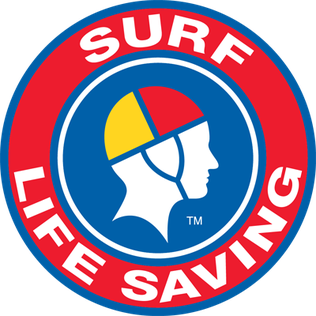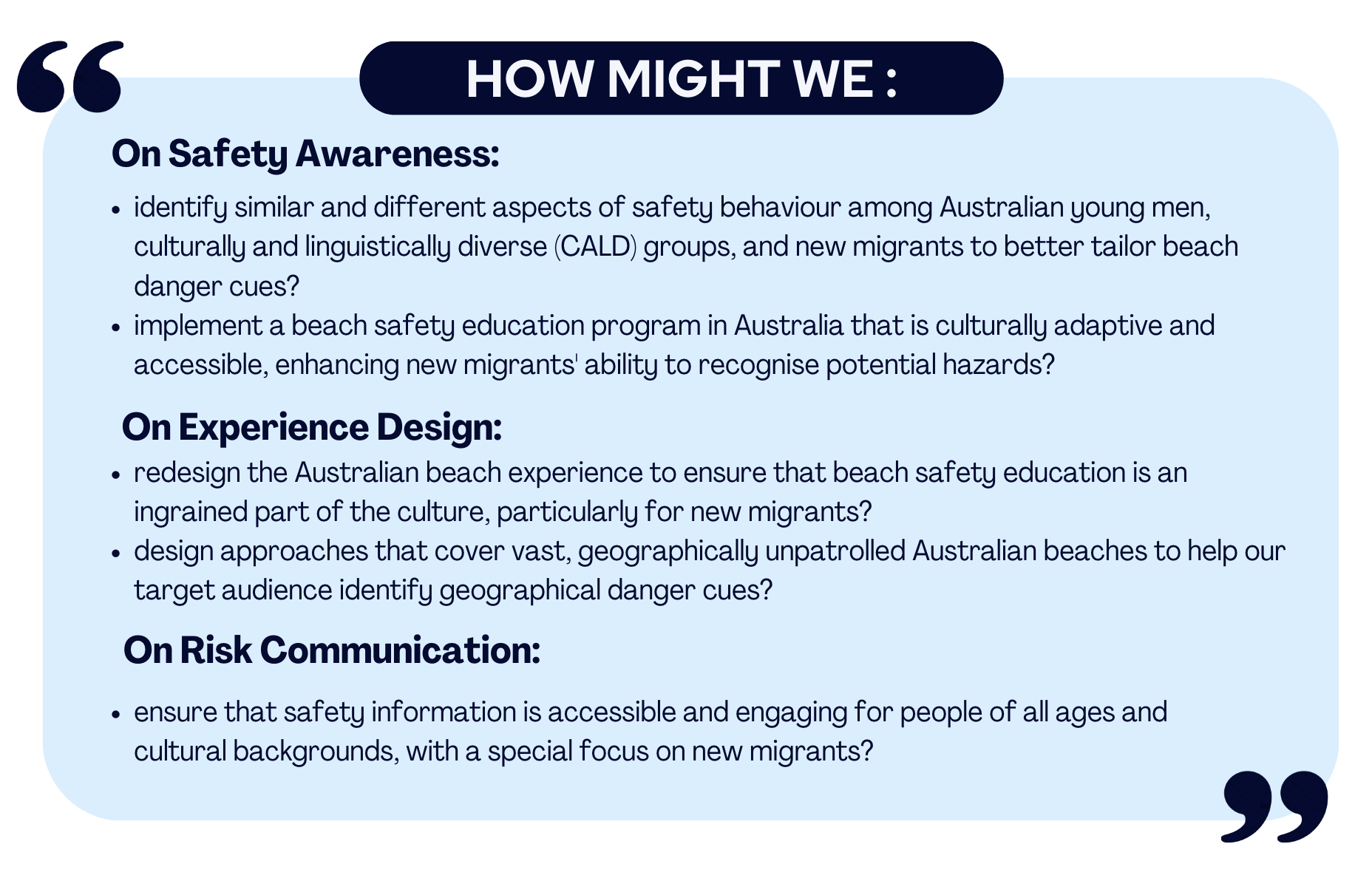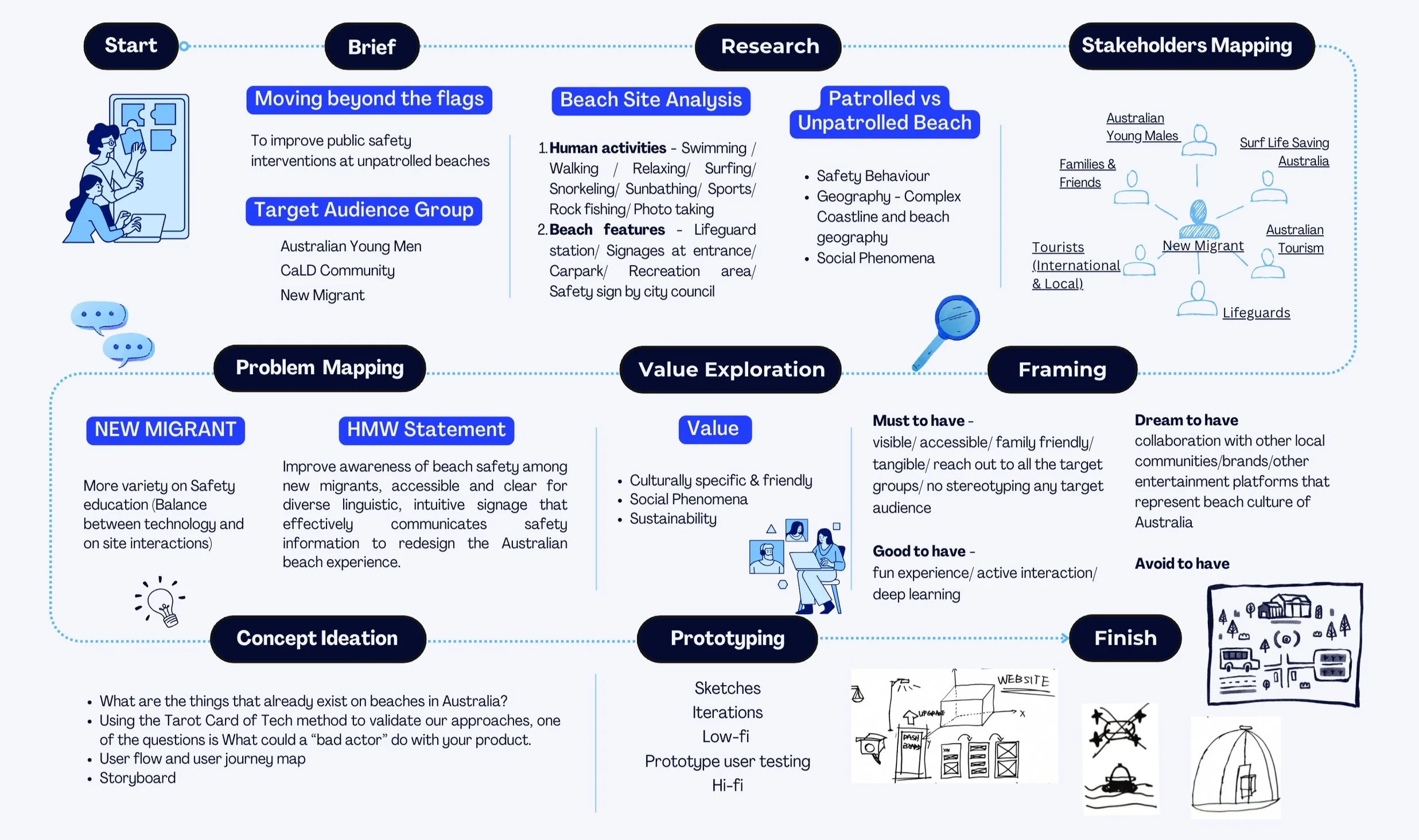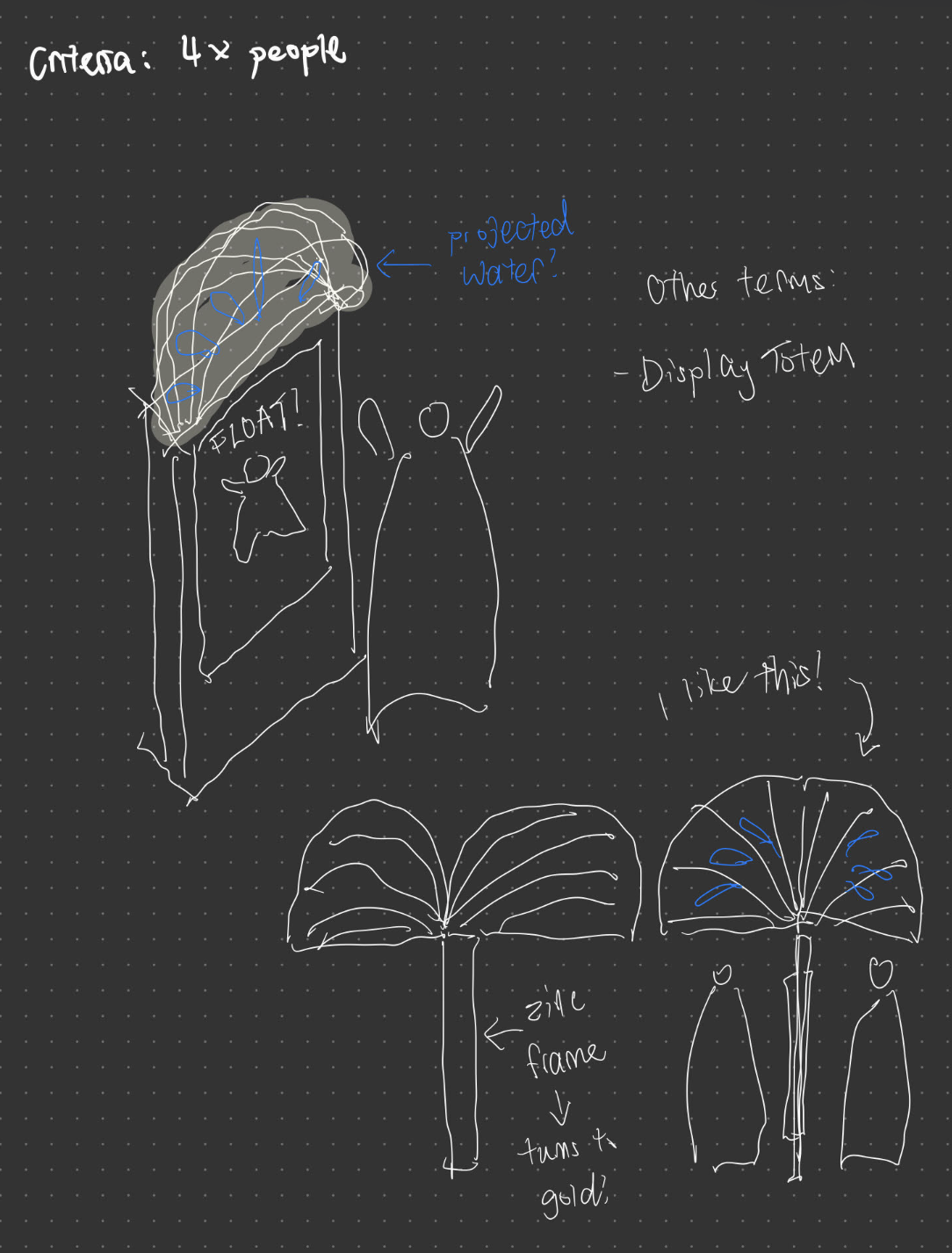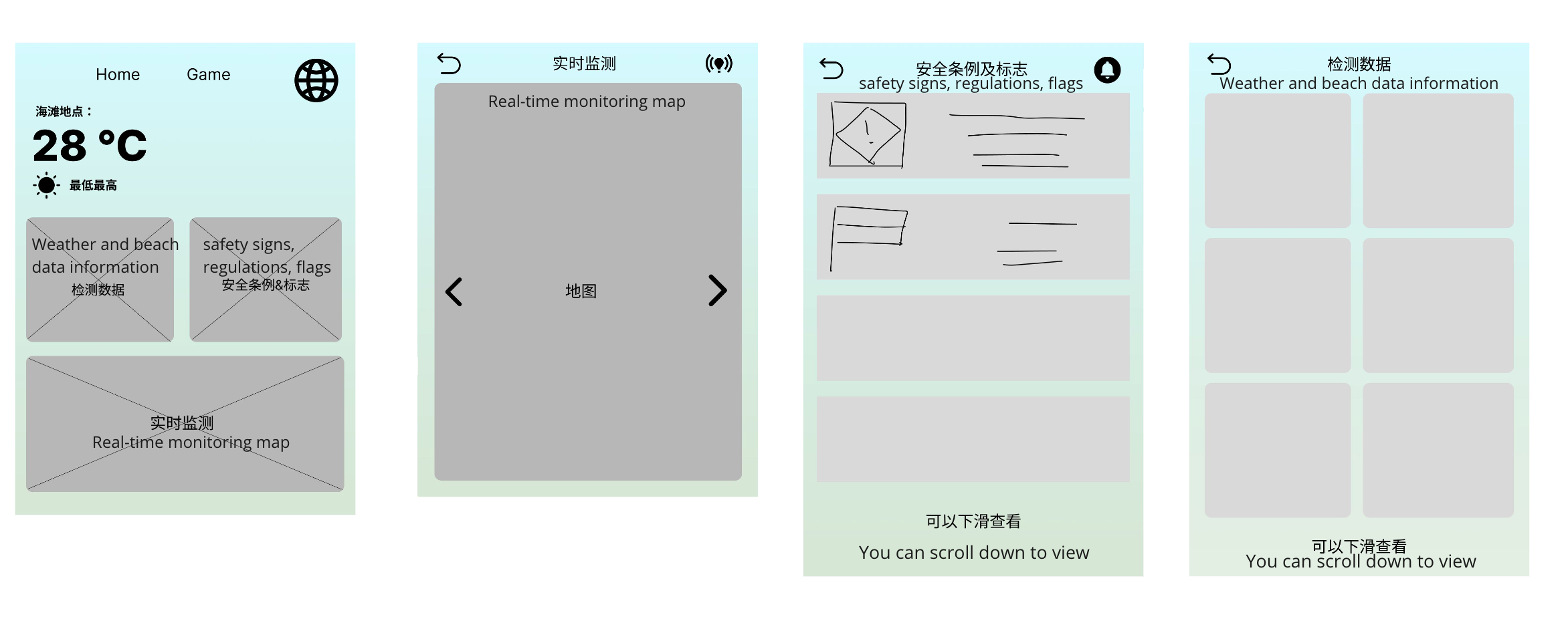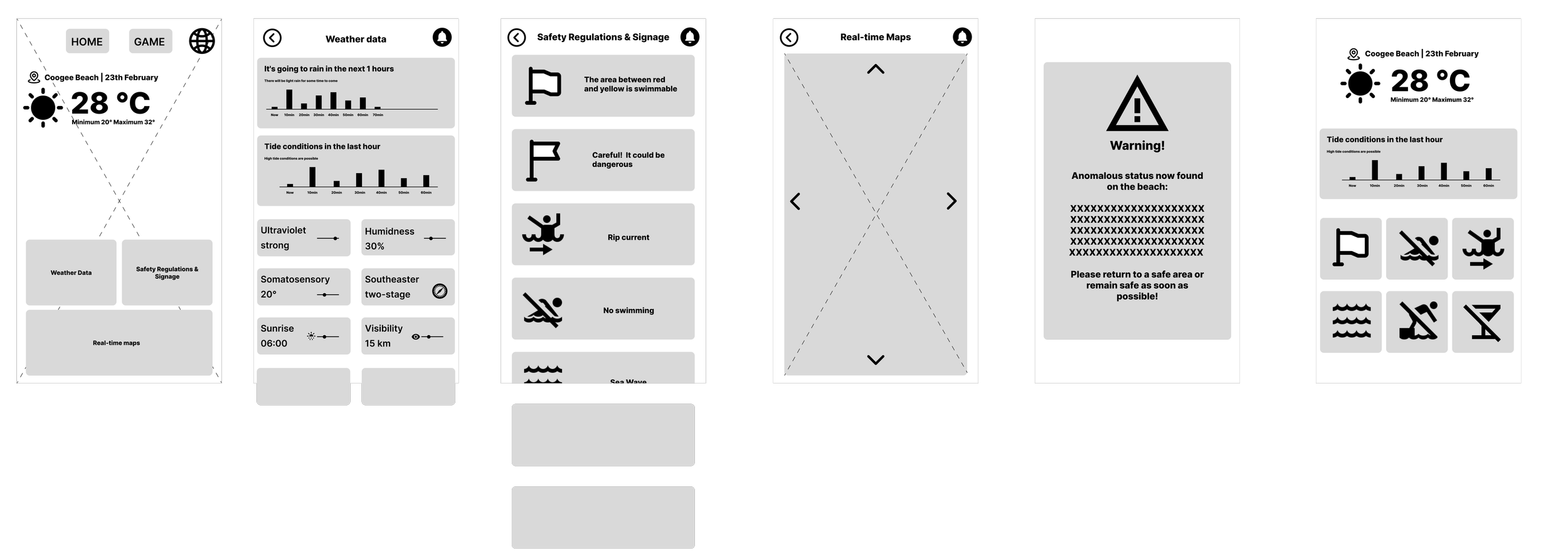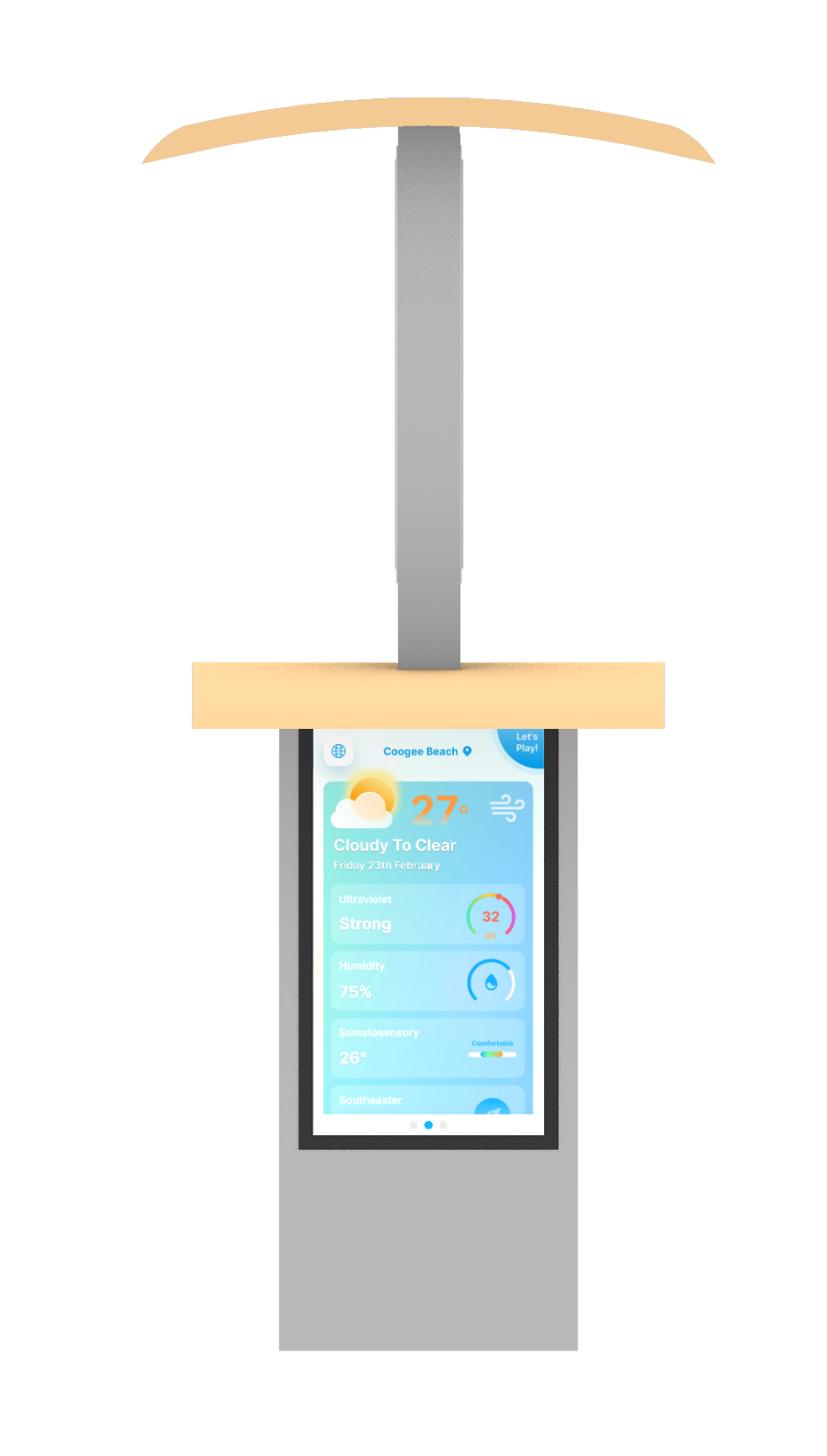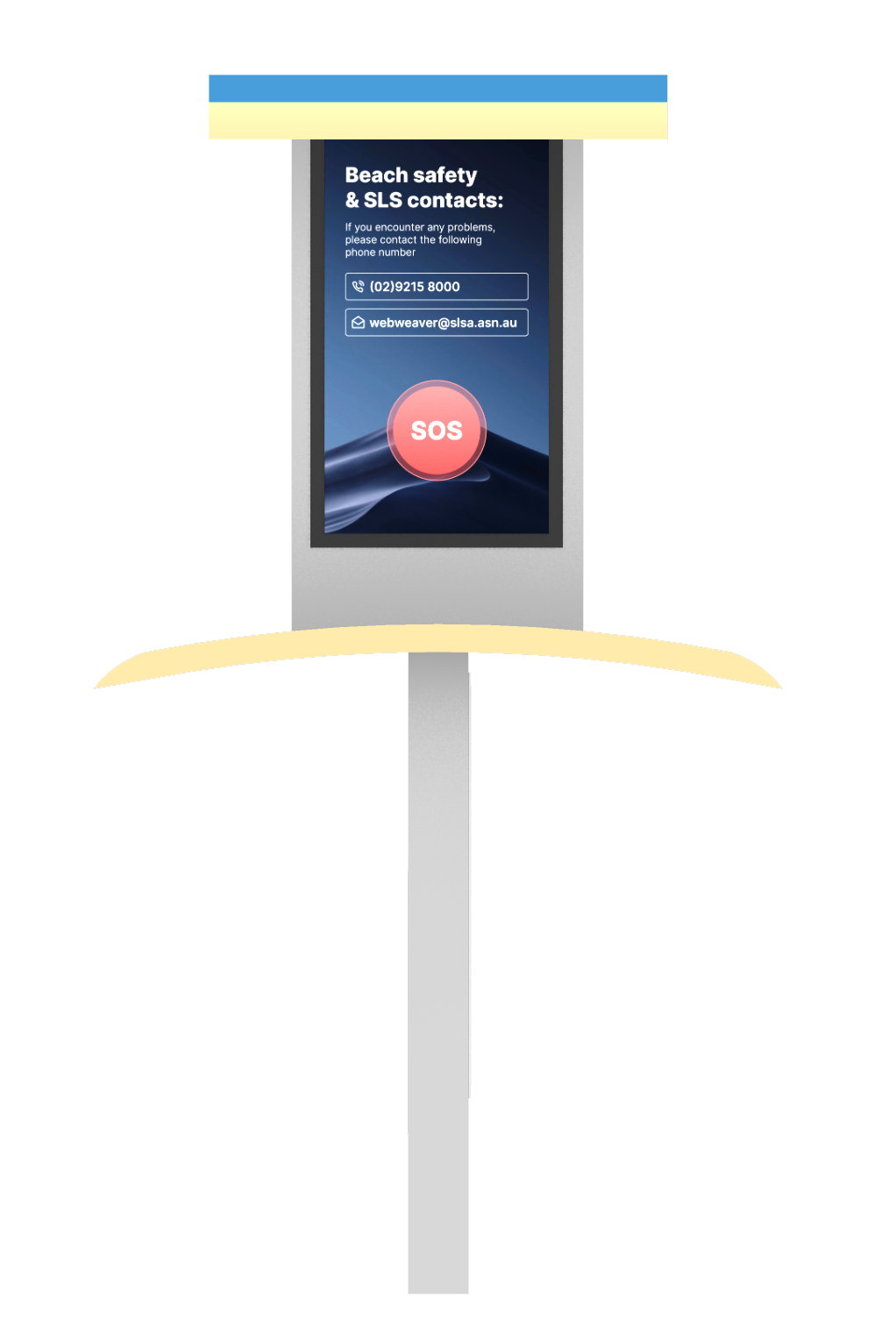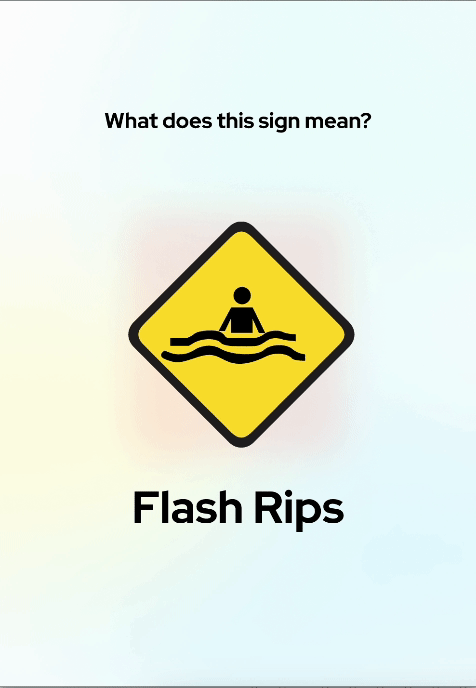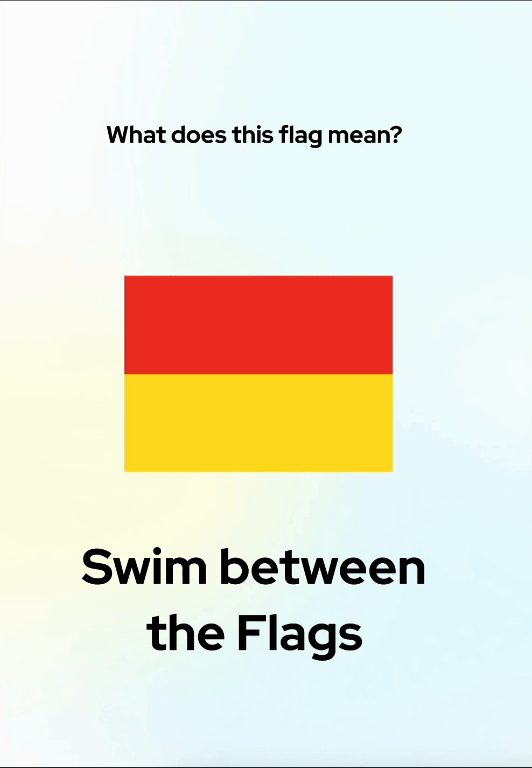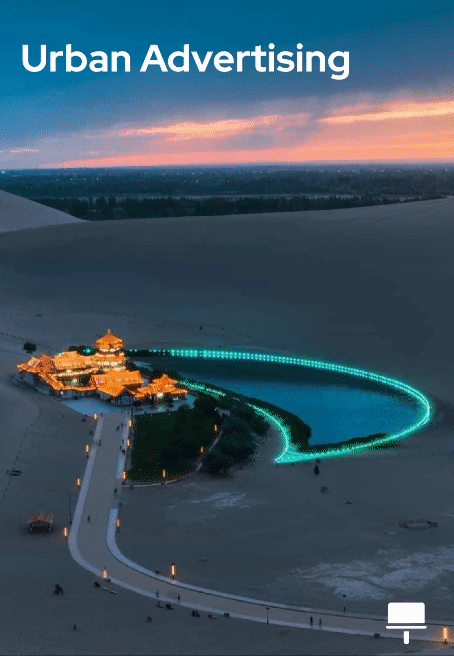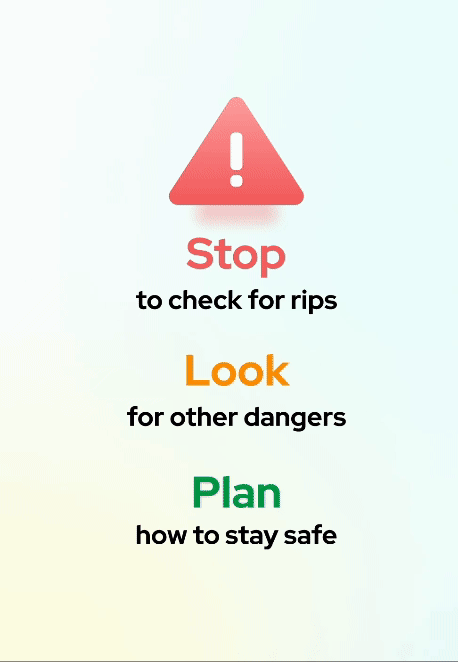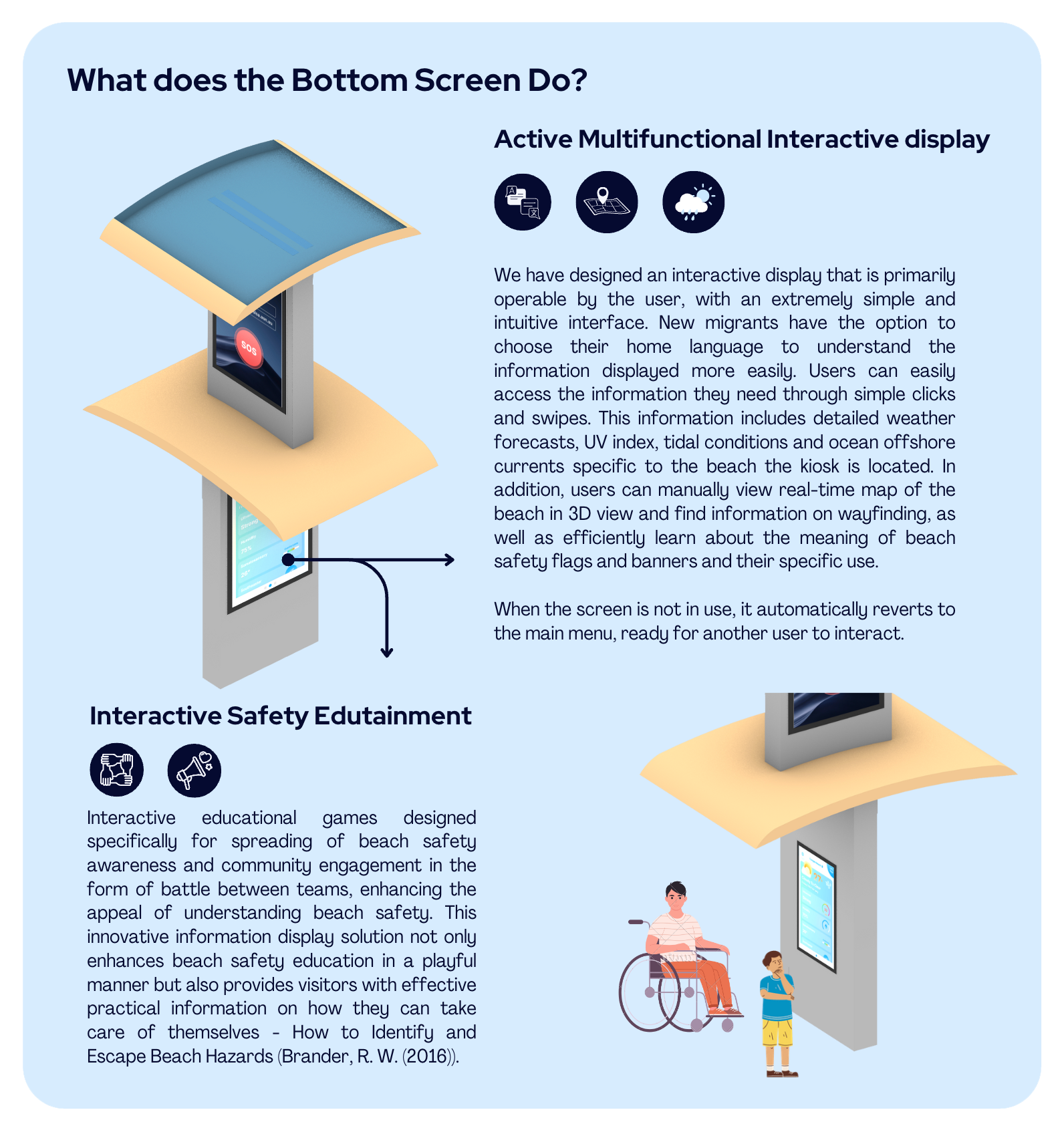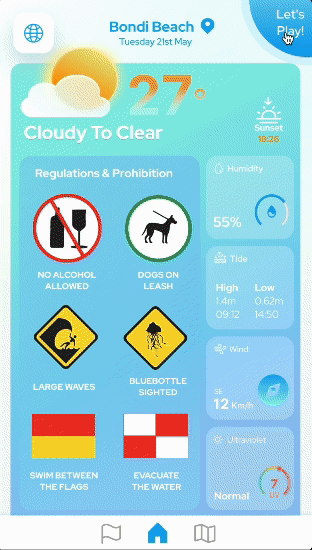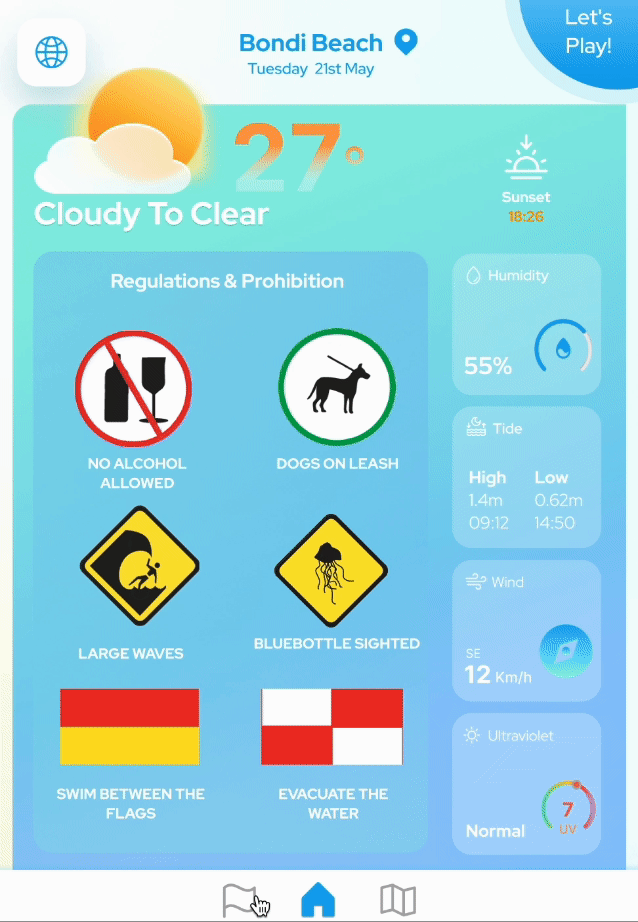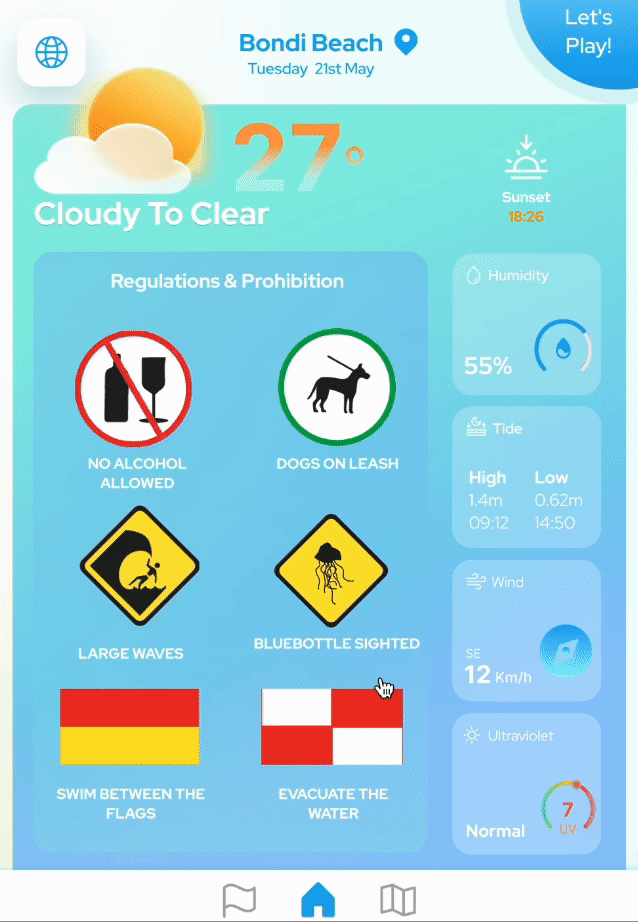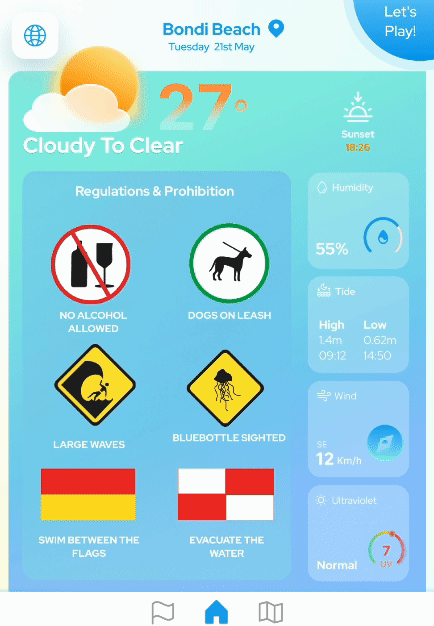SmartPod
Moving Beyond the Flags
Improving Public Safety Interventions at Unpatrolled Beaches
Team
Zeyu Guo
Carmen Shen Wen Chan
Ziyu Hua
Date
2024
Tool
Figma
Adobe Photoshop
SketchUp
Role
UX UI designer
Model designer
In partnership with Surf Life Saving Australia, the project enhances beach safety for new migrants in Australia by integrating safety education into their cultural experience. Through research and stakeholder input, culturally adaptive programs, community initiatives, and digital kiosks are developed to foster a safety culture aligned with migrants' backgrounds. The project focuses on inclusivity, engagement, visibility, accessibility, and sustainability to improve beach safety and social inclusiveness. The SmartPod covers the project's evolution from consultation to prototype development, aiming to redefine beach safety education for new migrants in Australia.
About the project
Research & insights
In our initial consultation with Surf Life Saving Australia, we recognised the need to ensure that everyone should find a safe place to enjoy themselves on the beach. During our analysis, we delved into aspects like beach education and the effectiveness of safety awareness, as well as the public's general behaviour towards beach safety. We discovered that diverse backgrounds, including geographical, cultural, and societal differences, significantly influence individuals' confirmation biases, attitudes, and awareness regarding beach safety in Australia. With a special focus on new migrants, who may lack local knowledge about beach safety cues and risks. Our research revealed that new migrants often come from diverse backgrounds, bringing varying degrees of familiarity with ocean environments, which significantly influences their perception of beach safety.
Field Research
In response to Surf Life Saving Australia's directive to bolster beach safety awareness, our team embarked on field research at both patrolled and unpatrolled beaches such as Gordons Bay, Clovelly Beach, and Coogee Beach. Our investigative efforts included interviews and surveys, specifically designed to understand the behaviours and preferences of our primary target groups: new migrants. Our findings illuminated a crucial gap in safety knowledge, particularly among these groups, who frequently underestimated the risks associated with beach environments. The data also highlighted a variety of human activities and specific beach features that could potentially enhance or compromise safety.
Original Approach
In our initial consultation with Surf Life Saving Australia, we recognised the need to ensure that everyone should find a safe place to enjoy themselves on the beach. During our analysis, we delved into aspects like beach education and the effectiveness of safety awareness, as well as the public's general behaviour towards beach safety. We discovered that diverse backgrounds, including geographical, cultural, and societal differences, significantly influence individuals' confirmation biases, attitudes, and awareness regarding beach safety in Australia. With a special focus on new migrants, who may lack local knowledge about beach safety cues and risks. Our research revealed that new migrants often come from diverse backgrounds, bringing varying degrees of familiarity with ocean environments, which significantly influences their perception of beach safety.
Our Approach
Driven by these insights, we have reframed our approach based on our How Might We questions from simply spreading safety awareness to embedding a culture of proactive safety within the beach experience. Our revised strategy encompasses:
- Developing targeted educational initiatives that address the specific needs and knowledge gaps of new migrants, ensuring that these key demographic groups are well-informed about the dynamics of beach safety.
- Encouraging active participation from local communities in safety education and promoting collaboration on areas that can enhance safety awareness of new migrant groups.
- Designing visual and intuitive signage that effectively communicates safety information, taking into account the diverse linguistic backgrounds and ways of knowledge comprehension in new migrants.

Design Principles
Inclusivity and Engagement: The design must be family-friendly and afford the accessibility for children, catering to all age groups. The design should be crafted that promotes vigorous user involvement and proliferates interactive opportunities.
Promote Safety Awareness: Priority should be given to ensure effective understanding of safety warning signage and safety education to enhance awareness and help the public establish a sense of safety at the beach.
Good Visibility and Accessibility: All elements within the design must be highly visible and complemented by convenient accessibility to accommodate a diverse group of people.
Prudent Budgeting: Efficiently steward financial resources to satisfy the project's essential needs without excess.
Maintain sustainability : Ensure our solution can further develop in the future and benefit both the environment and the community.
Fostering Government Partnerships: Sustain robust alliances with municipal and governmental entities, as well as support community groups which focus to aid new migrants settle in life in Australia such as Community Migrant Resource Centre, Settlement Council of Australia, and Australian Neighbourhood Houses and Centres Association (ANHCA). to bolster the project's progressive evolution (Commonwealth of Australia (Department of Social Services), 2017).

Concept Ideation
Initial Sketches
We began by investigating existing elements along Australia's beaches, with light poles being a prominent feature. After a thorough budgetary assessment, we innovatively transformed it into a dashboard, cleverly integrated into the umbrella structure. It provides shade for beachgoers, drawing their attention to interact with our design.
Game Sketches
Dashboard Interaction
Weather Dashboard Sketches
low-Fidelity Prototype
We built the user flow first to get better understanding on how the structure works. Based on the sketches we wanted to explore the meaning of the dashboard, the coherent design, the clean surface to interact with, think about how to encourage conscious seaside safety awareness learning, and take the design a step further by incorporating the necessary weather conditions.
User Flow
After creating initial wireframes, we conducted user tests with 8 people within the user group.
By utilising feedback from user testing, we defined the screen in more detail and changed the layout to better interact with our target audience groups.
High-Fidelity Prototype
Design.
SmartPod
A Digital Interactive Kiosk to help New Migrants learn Beach Safety on the Spot, with the help of local communities!
Side Views with Top Screen
Side Views with Normal Size Screen
Side Views with Accessible Size Screen
About the SmartPod
The SmartPod is our response to bridging the gap between new migrant communities and local communities. This digital interactive kiosk intends to serve as a one-stop informative platform dedicated to communicate beach safety awareness to help new migrant communities be aware of beach dangers in Australia in a straightforward and convenient manner, while simultaneously, being richly informed of the beach surroundings this kiosk is located.
Animated Signages
Weather Information
Safety Information
Game Feature
Weather Feature
Flag Information Feature
Map Search Feature
Multilingual Feature
Storyboard
Future Smart Connections with the SmartPod
Implementing the vision for 2030 and 2040, we can see the immense potential of combining smart technology with the SmartPod (Dr Seona Candy et. al, 2024). With the affordances of existing infrastructure such as light poles distributed among patrolled and unpatrolled beaches, light poles can be upgraded to smart light poles embedded with sensors to cover real-time information on surrounding conditions. Information can be readily extended to display conditions on various geographical locations on beaches across Australia, providing more specific real-time information and hazard warnings, significantly increasing coverage in enhancing public safety awareness.
In future development of the interactive mini games, the SmartPod can be equipped with a camera that can capture poses of the users interacting (Real-time Human Pose Estimation in the Browser With TensorFlow.js, n.d.) . Implementing this, with help of real-time information of open data on rip current speed, this can enhance interaction intuitiveness, providing a heightened realistic experience on how to escape a rip current without being caught in one.
So, what’s next?
Given the potential population growth in new migrants in near future (Population Projections | Planning, n.d.), they can be perceived as an essential force in Australia and should be a part of future smart cities initiatives. Their experiences in the beaches, which is an icon of Australia should be taken seriously and further studies and activities in the beach should be studied in order to enhance their safety awareness. Through such measures, we not only enhance the safety of beaches but also promote social inclusiveness, allowing new migrants to integrate into the community faster with the help of locals, and adding a touch of fun to beach fabric in an effort to integrate multi-cultural sensitive beach safety into the Australian beach culture.
This kiosk approach is also designed to sustain in the future both in its exterior structural but digital content. Each kiosk will be tailored to each beach, patrolled or unpatrolled, by the appearance of the frame that alters based on coastal weathering, to the digital content that is sensitive to the condition of the beach surrounding it. These features are a reflection for what can be enhanced in the future aligning with the future visions of Australia, which focus on engaging with the community and improve daily lives in real-time.
Future-Proofing
The SmartPod serves to provide an on-site interactive digital kiosk that can actively educate beach safety awareness to the new migrant community. With this approach that highlights real-world information with meaningful graphical direction, beach safety risks are not only educated on the spot, concise and align with the real-time condition of the beach and delivered briefly but communicated nonverbally which appeal to new migrants who come from diverse backgrounds and exposure to the beaches.
Education
To integrate this approach, we suggest to the SLSA to :
- Collaborate with Randwick City Council and new migrant community support groups to update more meaningful information for the digital content.
- Collaborate with local communities who have better exposure to their residential beaches labelled as unpatrolled beaches, to share their knowledge on safety cue utilisation that can be conveyed to this kiosk approach
Next Steps
Reflections
Working on this project with Surf Life Saving Australia has been an enlightening experience, highlighting the critical role of culturally sensitive safety education. Our goal was to design a comprehensive beach safety system tailored to new migrants, addressing their unique needs and challenges. Through extensive field research and collaboration, we identified significant gaps in safety knowledge and behaviours among new migrants. This project required us to reframe our approach, focusing on integrating safety education into the cultural experience of new arrivals.
My contribution involved conducting detailed site analyses, interviewing new migrants, and developing the concept of interactive digital kiosks. This process taught me the importance of empathy and inclusivity in design, ensuring our solutions are accessible and engaging for diverse audiences. By leveraging technology and community collaboration, we aimed to create a safer, more welcoming beach environment. This project has strengthened my skills in user-centred design and highlighted the value of multidisciplinary approaches in addressing complex social issues.

